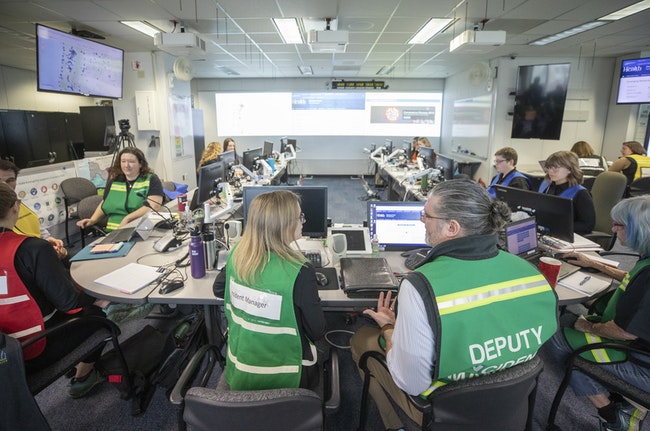 Staffers work together at the Oregon Health Authority’s Agency Operations Center in response to Coronavirus cases occurring in the state.(Jonathan House/Pamplin Media Group)
Staffers work together at the Oregon Health Authority’s Agency Operations Center in response to Coronavirus cases occurring in the state.(Jonathan House/Pamplin Media Group)
PORTLAND — The state of Oregon is prepared for a rapid increase in testing for COVID-19 should federal authorities, rattled by a rocky start, expand the criteria of who should be tested.
Last week, the Oregon Health Authority received 1,500 kits to test for the novel coronavirus, replacing kits that the Centers for Disease Control and Prevention discovered produced erroneous results.
Oregon now has the capacity to run 80 tests per day and has received commitment from the CDC for more test kits as needed. Testing is the only way to determine presence of the coronavirus. The CDC said it has the capacity to test 75,000 people nationwide.
During a media tour of the Health Authority’s operations center in Portland, Dr. Dean Sidelinger, state health officer and epidemiologist, explained the testing process and gave insight to how CDC guidelines have shaped the state’s response.
“With the emergency use authorization, since this is a new test given to us, we do have to follow their guidelines to use these (test) materials,” Sidelinger said. “They added the hospitalized criteria about a week ago after the California case, and they’ll continue to broaden those uses as the capacity to test increases.”
According to Sidelinger, at the beginning of this outbreak a few weeks ago, only the CDC was could test for COVID-19. As the quality assurance process in manufacturing test kits was clamped down, authorities last week determined that one of the three test components wasn’t working properly and tests here halted nationwide.
 State Epidemiologist Dr. Dean Sidelinger addresses the media during a tour of the Oregon Health Authority’s Area Operations Center for the Coronavirus. (Jonathan House/Pamplin Media Group)
State Epidemiologist Dr. Dean Sidelinger addresses the media during a tour of the Oregon Health Authority’s Area Operations Center for the Coronavirus. (Jonathan House/Pamplin Media Group)
Every lab, including Oregon’s had to be recertified to proceed with the coronavirus tests.
The Oregon State Public Health Laboratory in Hillsboro received certification on Friday, Feb. 28. Test results on eight cases are currently pending, and Oregon authorities also awaiting verification from the CDC on the three presumptive positive tests from patients in Umatilla, Clackamas and Washington counties.
To date, the Oregon lab has test results 28 people, with 17 clear of the virus, three positive and eight pending.
The Health Authority also reported that as of Monday evening, the state has monitored 327 people who don’t have symptoms but may have been exposed. Of those, 101 remain under monitoring and the rest were determined not to be at risk.
The three presumed cases involve an employee at a Lake Oswego elementary school who lives in Washington County, someone who lives in the same household, and an employee of a Pendleton casino.
State authorities said they’re confident the virus is spread through droplets, meaning one would have to come within at least six feet of an infected person to be exposed.
The CDC has recommended testing based on a mix of symptoms and patient history. Anyone with a fever and a severe lower respiratory illness that requires hospitalization should be investigated as a possible coronavirus case if there’s no alternative explanation for their symptoms, like influenza. Testing is also recommended for people with less serious symptoms who have recently traveled to an affected country or had close contact with another confirmed coronavirus patient.
The CDC has also revised criteria to test people sick enough to be hospitalized with uncertainty whether they have been exposed to the virus.
In Salem, Salem Health hasn’t yet tested any patients at its hospitals or clinics, according Dr. Ralph Yates, chief medical officer. One patient came into a clinic interested in a test based on recent travel, but medical providers determined after talking with county health officials he didn’t meet the criteria because of the length of time since he’d returned, Yates said.
If someone is not sick enough to see a doctor or go to the hospital but is still concerned they may have been exposed, they can call 211 to speak with a state worker about their risk, or contact their doctor’s office to determine whether they meet testing criteria. The state line is available in English and Spanish.
If Salem Health clinicians had a suspected case, Yates said, they’d contact the Marion County Health Department and Oregon Health Authority to consult and get permission from the state to send samples for testing in Hillsboro.
The test itself consists of two swabs — one in the mouth and one in the nose — and a sputum sample (saliva and mucus) for patients coughing, as well as a sputum sample for patients with a cough producing wet mucus or phlegm.
The state health lab can make an initial report or presumptive positive on whether someone has the novel coronavirus, but confirmation comes only from a CDC test. Samples are shipped overnight on ice to the CDC labs across the country.
Sidelinger said he expects to see testing criteria expanded by the CDC and put into the hands of commercial labs as even more people are tested for the virus.
“We’re very confident in the results coming out of our public health lab as we await confirmation from the CDC,” Sidelinger said.
On Saturday, Feb. 29, the federal Food and Drug Administration (FDA) expanded its emergency use authorization policy to allow more labs to apply for approval to test for COVID-19.
According to FDA spokeswoman Stephanie Caccomo, the FDA can’t comment if facilities in Oregon have applied to be certified for testing for COVID-19.
Calls to commercial and academic medical facilities throughout Oregon Tuesday yielded no answers as to whether any were in the process of applying to begin testing.
The process for taking test samples requires use of a negative pressure room, an isolation technique to prevent cross-contamination. Sidelinger said he’s unsure of the number of rooms spread throughout Oregon’s healthcare provider systems.
“As we have with other diseases, we want to make sure we have the most protection for people we can,” he said. “We know healthcare providers are exposed to sick people all day, not just intermittently, and we need them to be on the frontlines caring for people, so the recommendation for use of those negative pressure rooms and isolation is in place not just to protect patients, but to protect our healthcare providers, especially during specimen collection.”









